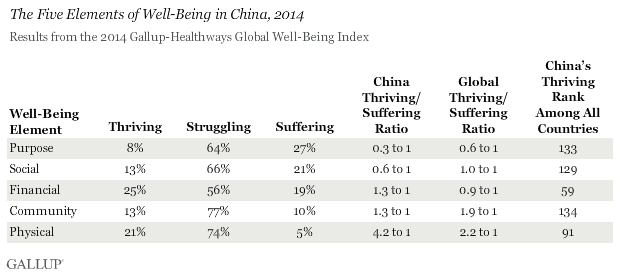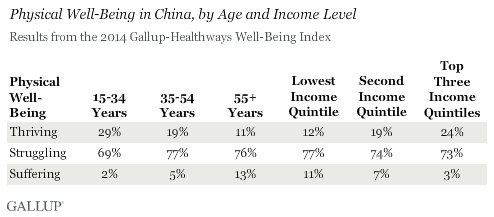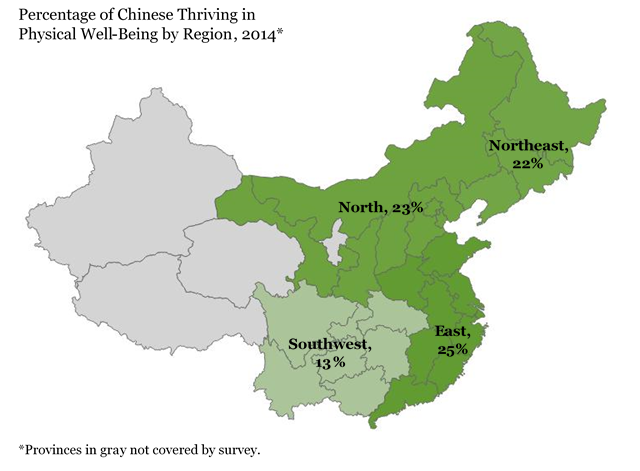STORY HIGHLIGHTS
- Benefits of healthcare spending felt unevenly among citizens
- 21% of Chinese thriving in physical well-being; 5% suffering
- Isolation of the poor and elderly is an urgent healthcare issue
In recent years, the Chinese government has launched a major initiative to increase healthcare spending, which rose from 4.7% of GDP in 2004 to 5.6% in 2013, and the country has built thousands of hospitals and other healthcare facilities.
However, as with other aspects of China’s much-touted “economic miracle,” the benefits of this healthcare spending have been felt unevenly among the population. Certain groups — including the elderly, low-income and rural Chinese — remain vulnerable with regard to one of the five key components of well-being: physical health.
Measuring Well-Being
Any strategy for promoting people’s overall well-being requires a holistic view, and this is as true in China as it would be anywhere else. This holistic view must consider how a single aspect of well-being — such as physical health — is interconnected with and influenced by other aspects, including a person’s financial security, social relationships, connection to community and daily purpose. Gallup and Sharecare have found that taking an integrated approach to measuring and managing well-being is related to a higher quality of life and improved efficiency in many areas, including in the workplace.
The concept of well-being encompasses all the ways people think about and experience their lives. The Gallup-Sharecare Global Well-Being Index gathers data from populations worldwide to assess people’s perceptions of their own experiences regarding five elements:
- Purpose: liking what you do each day and being motivated to achieve your goals
- Social: having supportive relationships and love in your life
- Financial: managing your economic life to reduce stress and increase security
- Community: liking where you live, feeling safe and having pride in your community
- Physical: having good health and enough energy to get things done daily
In analyzing the results of the index, Gallup and Sharecare classify responses as “thriving” (well-being that is strong and consistent), “struggling” (well-being that is moderate or inconsistent) or “suffering” (well-being that is low and inconsistent). Gallup does not ask respondents to classify their experiences according to these labels.
In 2014, 21% of Chinese were thriving in physical well-being. This percentage is somewhat lower than the global figure for that year (24%). There was a more notable difference at the low end of the scale, however; just 5% of Chinese were suffering in physical well-being, less than half the 11% seen among the global population. In other words, for every Chinese suffering in physical well-being, 4.2 are thriving; among the global population, the ratio is lower, at 2.2:1. Moreover, Chinese are considerably less likely to be suffering in physical well-being (5%) than their neighbors in South Korea (20%) or Japan (19%).
The other element in which China’s thriving-to-suffering ratio is higher than the global ratio is financial well-being. This finding reflects the country’s rapidly rising living standards. However, these gains have also resulted in rising income inequality.
Physical Well-Being Significantly Lower Among the Oldest and Poorest
China’s economic rise and the dramatic reduction in poverty that has accompanied it is good news for health conditions among the population. The proportion of Chinese satisfied with the availability of quality healthcare in their communities rose from 56% to 65% between 2007 and 2013, according to Gallup World Poll trends. Further, the proportion who reported having health problems that keep them from doing things other people their age can normally do fell substantially, from 24% in 2007 to 15% in 2008, and has remained between 13% and 17% since.
China’s population is far from homogenous, however, and conditions often vary substantially by age and income. Though 21% of Chinese overall are thriving in physical well-being, almost three times as many Chinese aged 15 to 34 are thriving (29%) as those aged 55 and older (11%). Similarly, Chinese with average or above average incomes are twice as likely to be thriving in physical well-being (24%) as those in the bottom income-earner category (12%).
Given China’s aging population, caring for the elderly has become a major concern. Though Chinese overall are more likely than South Koreans or Japanese to be thriving in physical well-being, in China this figure declines much more sharply with age. A study published in 2014 by the journal International Health found that elderly Chinese, especially those in rural areas, had high rates of chronic disease and often went without any form of preventive healthcare.
Thriving Most Common in China’s Dynamic Eastern and Northern Regions
Physical well-being results also vary considerably by region in China. The percentages thriving in physical well-being are highest in the more economically vibrant Eastern, Northeastern and Northern regions and are lower in the less-developed provinces to the Southwest. (The large but sparsely populated westernmost provinces — Xinjiang, Tibet and Qinghai — were not covered by Gallup’s survey in 2014.)
How to Move More People From Struggling to Thriving in Physical Well-Being
China’s remarkable progress in broadening access to basic healthcare is evident in the low 5% of residents who are suffering in physical well-being. Health plans, insurers, employers and policymakers can now place a greater focus on supporting the 74% who are struggling to become thriving in this element.
China’s poor and elderly populations, in particular, need more help in accessing preventive healthcare and disease management services. This includes developing strategies that make it easier for older and rural Chinese to maintain a routine schedule with local healthcare providers and that help relatives living in other areas to monitor their parents’ and grandparents’ health conditions and use of local healthcare services.
Increasing physical well-being, though, cannot be considered in isolation from the other well-being elements:
- Strong and improving financial well-being reflects robust economic and employment conditions, which in turn promotes access to and use of healthcare services. Encouraging a sense of daily purpose — especially as it relates to living a healthy life — could achieve a similar result.
- Boosting levels of social and community well-being — which currently are comparatively lower than levels of physical and financial well-being — could also help ensure that people have a supportive network that encourages them to maintain a preventive healthcare regimen or manage a chronic condition, especially if their immediate family members are far away.
“China’s focus on improving its population’s well-being will be of paramount importance in the coming decades to manage its key demographic and healthcare challenges,” says Peter Choueiri, president of Sharecare International. “Studies have shown that a higher state of well-being leads to a higher quality of life, higher productivity and reduced healthcare costs.”
SURVEY METHODS
Results for the Gallup-Sharecare Global Well-Being Index are based on telephone and face-to-face interviews on the Gallup World Poll, with a random sample of approximately 146,000 adults, aged 15 and older, living in 145 countries and areas in 2014. Gallup-Sharecare Global Well-Being Index results for China are based on landline telephone and face-to-face interviews conducted between Sept. 20-Nov. 18, 2014, as part of the Gallup World Poll, with a random sample of 4,696 adults, aged 15 and older, living in China.
For results based on the total sample of national adults in China, the margin of sampling error is ± 2.2 percentage points at the 95% confidence level. All reported margins of sampling error include computed design effects for weighting.
All country-level analyses use country weights. Global and regional analysis uses projection weights that account for country size. Minimum sample sizes of n=300 apply.
In addition to sampling error, question wording and practical difficulties in conducting surveys can introduce error or bias into the findings of public opinion polls.
Each element in the Global Well-Being Index contains two questions asked of all respondents:
Purpose Well-Being:
- You like what you do every day.
- You learn or do something interesting every day.
Social Well-Being:
- Someone in your life always encourages you to be healthy.
- Your friends and family give you positive energy every day.
Financial Well-Being:
- You have enough money to do everything you want to do.
- In the last seven days, you have worried about money.
Community Well-Being:
- The city or area where you live is a perfect place for you.
- In the last 12 months, you have received recognition for helping to improve the city or area where you live.
Physical Well-Being:
- In the last seven days, you have felt active and productive every day.
- Your physical health is near-perfect.
Learn more about the Gallup-Sharecare Global Well-Being Index.


